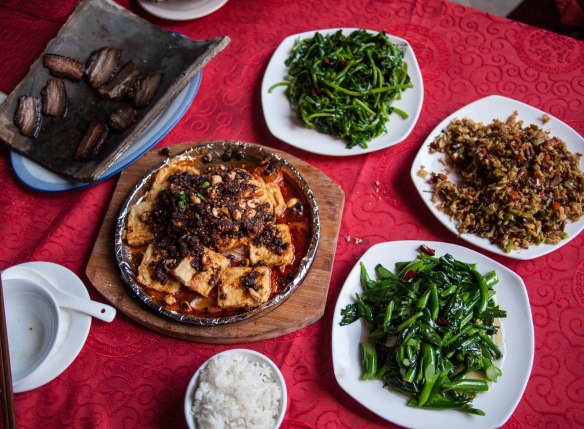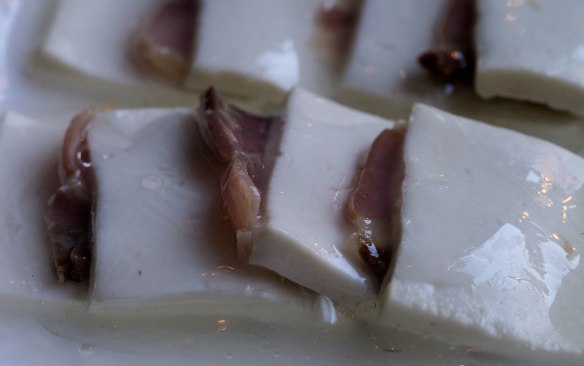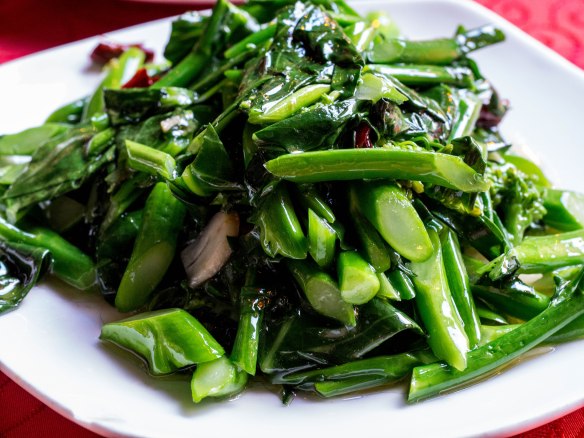One may not think of Kunming as a culinary hotspot, but it does have some very good restaurants. The food has a definite Sichuan influence with the liberal use of chili peppers and some Sichuan peppercorns, but it is not as spicy as mainstream Sichuan cuisine. Another wonderful thing about Kunming, and Yunnan in general, is the ethnic minority populations. The unique cuisines of these various groups have found their way into Chinese cooking to give it some interesting and delicious variations. For example, one does not think of cheese in Chinese cuisine, but it can be found in Kunming, and is probably an influence from one of the ethnic minority groups.
One night my friend and colleague Michael and I found a superb restaurant in Kunming. We were there doing research on Sichuan cuisine and the many variations to it in the surrounding areas. I think we found this restaurant on a Chinese food blog or forum. It was called, 一颗印昆明老房子 yì kēyìn kūnmíng lǎo fángzi and was in an old courtyard style house tucked away in a back alley. The house was more than a hundred years old and had an historical plaque out front. People seem to eat early in Kunming; the restaurants empty out by about 8:30 pm. We thoroughly enjoyed sitting in the courtyard on a beautiful clear day, about 70 degrees, blue skies with a few white puffy clouds. The restaurant was very crowded, as good restaurants usually are.
Our practice when visiting a new restaurant is to talk to the server about their speciality dishes. In other words, what are the dishes that the restaurant is known for. We also try to get a sense for the local food scene. Our server at this particular restaurant was pretty helpful. At one point she called another girl over to help answer our questions. We wanted to order local specialties and were not disappointed. We ordered six dishes.
1. 瓦掌风肉 wǎzhǎng fēngròu, Pork on a curved tile
Yunnan is famous for their hams, and I suppose this dish follows in that tradition. This fatty pork had a deep, smoky flavor similar to bacon. But it was not as salty and had a more “wild” flavor than the bacon we eat here in the U.S. It was fatty and rich, and was served, and probably cooked, sizzling on a hot curved roof tile. This was a great dish, not typical of many Chinese dishes.
2. 云腿夹乳饼 yúntuǐ jiā rǔbǐng, Yunnan ham in cheese
This is the first time I have eaten cheese at a Chinese restaurant; I have eaten yak cheese in other parts of Yunnan and in Tibet, but that was Tibetan food, not Chinese. This was a unique dish with tender slices of salty, flavorful ham with a mellow, fresh white cheese. The cheese had the consistency of a fresh mozzarella, but a little firmer, and was quite tasty. I’m not sure how popular this dish is with the Chinese, but we really enjoyed it.
3. 铁板包浆豆腐 tiěbǎn bāojiāng dòufu, Tofu with fermented soybeans
This was a fried tofu dish served on a hot iron plate. I really don’t know what the 包浆 bāojiāng in the name of this dish refers to. The tofu was firm and chewy on the outside and soft on the inside as a result of being fried. This dish also had a delicious sauce made with fermented and seasoned soybeans 豆豉 dòuchǐ (see this post for more on this wonderful seasoning: https://intothemiddlekingdom.com/2014/01/27/spectacular-meals-guiyang-%E8%B4%B5%E9%98%B3/). Seasoned and fermented soybeans are a wonderful mix of chewy and crunchy with an earthy, salty taste. They go well with the blandness of tofu. The tofu was served on a bed of sauteed onions. I am huge fan of tofu and 豆豉 dòuchǐ, so I really loved this dish. the flavors were complex and the tofu was cooked to perfection. I especially like tofu that is fried like this as it gives it a nice meaty texture.
4. 外婆菜炒鸡蛋 wàipó cài chǎo jīdàn, Grandmother’s vegetable with scrambled egg
I love eggs in any form, especially in Chinese food. The Chinese use eggs quite frequently in all the different kinds of regional cuisines. This was an excellent dish. I’m not exactly sure what the “grandmother’s vegetable” refers to in the Chinese name of this dish. This particular dish had little bits of seasoned pork, some fermented soybeans, some bell pepper, and of course scrambled egg. It may be that this is one of those dishes where you can throw in whatever vegetables you may have on hand. This dish was very flavorful, probably due to the pork and soybeans.
5. 清炒芥兰 qīngchǎo jièlán, Fresh stir-fried Chinese broccoli
This is a pretty basic dish that you can find just about anywhere in China. This particular version was cooked with garlic, dried red pepper (the Sichuan influence) and some small bits of mushroom. Nothing extraordinary, but quite good.
6. 清炒豆尖 qīngchǎo dòujiān, Fresh stir-fried bean sprouts
This was a local vegetable, which based on the name, is probably some kind of a bean sprout. Again, nothing extraordinary, but very delicious. No Chinese meal is complete without some good stir-fried greens.
This was one of those spectacular meals that I have eaten in China in the past couple years. One of the things that made it so good was the variety of the dishes and the uniqueness of the local flavors. If I were ever back in Kunming I would certainly go back to this fine restaurant.















The ‘A type of bean sprout?” looks like the classic, rarely listed Snow Pea Greens: the tendrils are a feature of this delicate green dish.
Hello, Prof. I will be in Kunming soon. Where exactly is this particular restaurant? I look forward to hearing from you. Many thanks.
Here is the address,
云南省昆明市东风西路吉祥巷18-19号
Yunnan Province, Kunming City, Dongfeng West Rd., Jixiang Lane, #18-19.
And a link to the place on Trip Advisor. Good luck. Let me know how you like it.
http://cn.tripadvisor.com/Restaurant_Review-g298558-d1546040-Reviews-YiKe_Yin_Lao_FangZi-Kunming_Yunnan.html
Matt
Yunnan is good with their hams and tofu.
It is interesting to know that this place takes influences from sichuan food, but puts a certain cultural twist on the food. It is also pretty cool to know that there is Cheese in the food here, as the Chinese do not often eat cheese with their food.
I’ve never personally come in contact with cheese in any kind of Chinese food but I’ve heard of it prior to this post. I had imagined it being in a style similar to that of an Indian Paneer dish, but the way that it was shown here was not foreseen.
This makes we want to visit Kunming that much more. All those specialty dishes look amazing. I could really go for some of grandma’s vegetables with scrambled egg and the pork belly right about now!
It’s interesting to see cheese be used in Chinese cuisine. Next time I visit, I would like to try more food from the areas of ethnic minorities. It is interesting to see how the minorities incorporated their cuisine with what is considered Chinese cuisine.
Given the lengthy history of Chinese cuisine and cooking, it is very interesting to see ethnic minority style’s infiltrating Chinese cuisine and meshing so well. Since the recipes are so old, one would think why change them given they have survived multiple generations and the test of time. For me, the biggest change, as seen in this post, is the addition of cheese, not something usually seen, but definitely something to try.
This article was very interesting to me as it shows some of the original culture that is put into traditional Chinese cuisine. While also adding in modern aspects of food that is not commonly see such as chesses within a Chinese dish. Something that I found very interesting was that the cook the pork from the dish of wǎzhǎng fēngròu on traditional Chinese roof tiles.
Kunming is a culinary hotspot, it has amazing restaurants all around and a very sichuan influence in the food. There is usage of chills peppers, peppercorn. It has a very unique cuisines that is fawned upon by many. There are also many ethnic groups that are using many different types of ingredients not traditionally found in the Asian diet such as cheese and many different types of spices.
The “wàipó cài chǎo jīdàn” looks very tasty. it is so amazing to think about all the things that eggs can be turned into. tiěbǎn bāojiāng dòufu, also looks really good. I hope to try it one day, as i am a big fan of tofu. Kummings loooks like a really good city for food. I had no idea that chess was not a primary staple in the typical asian diet, that is such an interesting cultural diffrence.
I haven’t previously heard of Kunming but after reading this article, I’m very interested in going. The author even uses first person experience which further increases their credibility. I enjoyed reading about the method they would use to discover the good cuisine in each area and found the best dishes to try. I personally thought the pork belly on a curved tile looked especially good.
I don’t think I’ve ever heard of cheese being used in any Chinese meals before. It sounds like it tastes amazing, and I’d love to visit Kunming in the future, even just to taste the food. It is interesting to hear about how different cultures mix and affect each other, especially when this mixture results in different kinds of foods. You get a little taste of both cultures in one dish.
This restaurant is stunningly beautiful. I love the look of the building, you can tell there is a fascinating history there. It seems like it would be a really amazing experience to eat in that courtyard. The cheese and pork dish seems very interesting! If you would have asked me what ingredient I least associated with Chinese food, cheese would have been at the top of the list. I can’t help but be very curious what it must taste like; it looks delicious!
Reading this post was the first time I had ever heard of Kunming. However, after reading this post, it made me want to learn more about Kunming and their culture. I really enjoyed learning about the various twists that Kunming has on traditional Chinese dishes. I think that it’s really interesting how a city was able to take traditional dishes that put their own spin on it that allowed them to separate themselves. Personally, I was very fascinated by 云腿夹乳饼 (Yunan ham in cheese). I had never thought of it until the author mentioned that you don’t normally see cheese in Chinese cuisine yet this one Kunming restaurant was able to incorporate Cheese and Yunnan ham into one harmonish dish. This article shows that even traditional, well-established elements of Chinese culture such as Chinese dishes can still have originality. I think that by having these different twists on Chinese dishes allows many people in Kunming to personalize their dishes and make it unique to their familial tastes and values. This shows the diversity that China has in even the small elements such as Chinese cuisine.